When you light a Candle Massage Oil is a skin‑friendly massage oil that also works as a scented candle, melting into a warm, lubricating liquid for a soothing massage, you get ambience and nourishment in one go. This guide breaks down which formulas work best for different skin types, what ingredients to look for, and how to use them safely.
Key Takeaways
- Look for oils with a low melting point (around 45‑55°C) so the candle melts quickly without burning the skin.
- Natural bases like soy wax, shea butter, and coconut oil are gentle on sensitive skin.
- Essential oils not only provide fragrance but can target specific skin concerns - lavender for soothing, tea tree for acne‑prone skin.
- Check for fragrance‑free or hypoallergenic options if you have allergies.
- Always perform a patch test 24‑hours before a full‑body session.
What Is a Candle Massage Oil?
A candle massage oil is a hybrid product that starts as a solid candle, usually made from a blend of waxes and butters, and turns into a liquid oil when the flame melts it. The idea is simple: you enjoy the calming glow and scent, then dip your hands into the warm oil for a glidey massage. Because the oil is designed to stay at skin‑friendly temperatures, you never risk burns that can happen with regular hot‑stone or oil heating methods.
Why Choose Candle Massage Oil Over Regular Oil?
- Atmosphere: The candle adds visual and aromatic relaxation, turning a routine massage into a spa‑like experience.
- Temperature control: The wax melts at a predictable temperature, ensuring the oil stays warm but never scalding.
- Ingredient synergy: Many formulas incorporate nourishing butters that moisturize while you massage.
Key Ingredients to Look For
Understanding the building blocks helps you match the product to your skin’s needs.
- Soy wax - a plant‑based wax with a low melting point, ideal for gentle heat.
- Shea butter - rich in vitamins A and E, it moisturises and soothes dry patches.
- Coconut oil - provides a silky glide and has natural antimicrobial properties.
- Essential oils - add scent and therapeutic benefits; lavender for relaxation, eucalyptus for muscle relief, and rosehip for skin regeneration.
- Vitamin E - acts as an antioxidant, extending shelf life and protecting skin cells.
Best Candle Massage Oils for Different Skin Types
| Product | Base Wax/Butter | Key Essential Oils | Best For |
|---|---|---|---|
| Silk Glow Candle Oil | Soy wax + shea butter | Lavender, geranium | Dry or mature skin |
| Pure Calm Wax | Coconut oil + beeswax | Chamomile, ylang‑ylang | Normal to oily skin |
| Allergen‑Free Serenity | Soy wax only | None (fragrance‑free) | Sensitive or allergy‑prone skin |
| TheraTherm Healing Candle | Shea butter + mango butter | Eucalyptus, peppermint | Muscle soreness, active lifestyles |
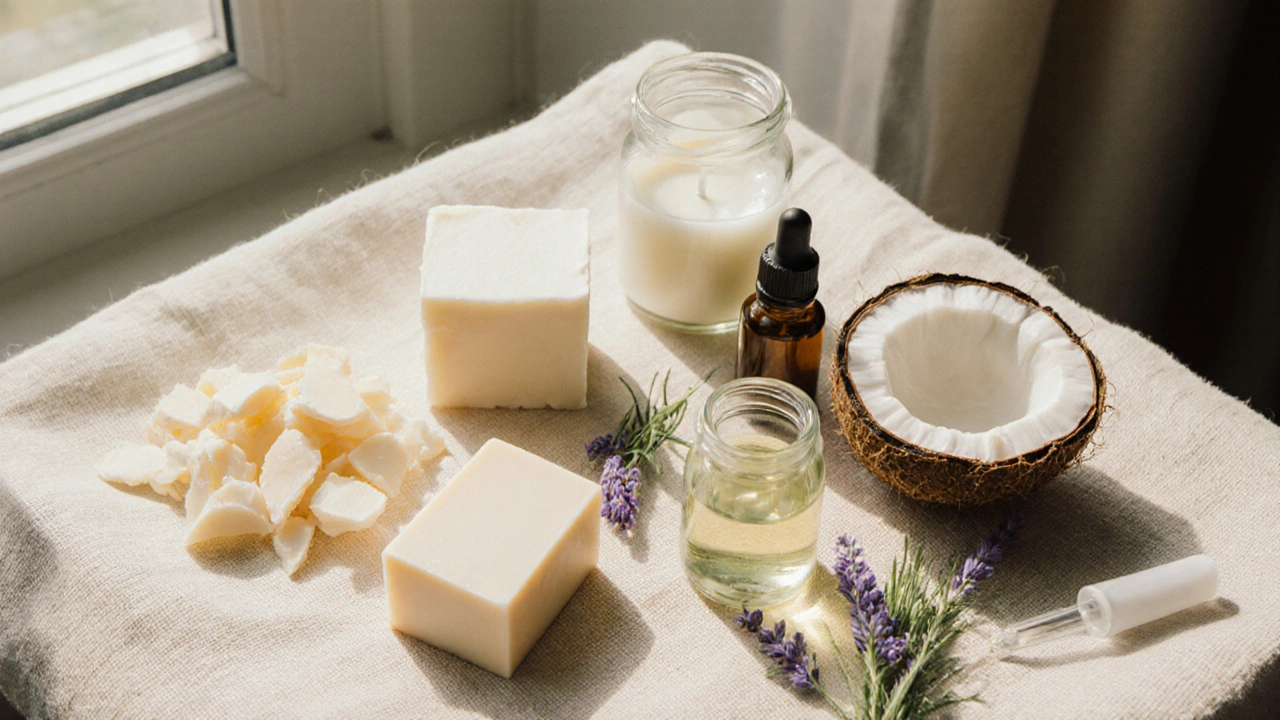
How to Use Candle Massage Oil Safely
- Trim the wick to about 5mm to prevent a high flame.
- Light the candle and let it burn for 3‑5minutes until a pool of liquid forms.
- Extinguish the flame - the oil stays warm for 10‑15minutes.
- Test the oil temperature on the inside of your wrist; it should feel comfortably warm, not hot.
- Apply a small amount to your hands, then massage in smooth strokes. Re‑dip as needed.
- After the session, wipe any excess with a soft towel and moisturise if desired.
Always keep the candle away from flammable fabrics and never leave it unattended.
Patch Test - Your First Line of Defense
Because many candle oils contain essential oils, a patch test helps catch potential reactions early. Apply a pea‑size amount on the inner forearm, cover with a bandage, and wait 24hours. If redness, itching, or swelling occurs, avoid that product.
Choosing the Right Scent for Your Mood
Beyond skin benefits, aroma plays a big role in the overall experience.
- Lavender - classic calming scent, great for bedtime massages.
- Rose - romantic, ideal for couples sessions.
- Citrus blends (orange, grapefruit) - energising, perfect for morning wake‑ups.
- Vanilla - warm and comforting, works well for stress relief.
DIY Candle Massage Oil - When You Want Full Control
If you enjoy crafting, making your own candle oil lets you pick every ingredient.
- Combine 1cup soy wax flakes with ¼cup shea butter in a double boiler.
- Heat gently until fully melted, stirring occasionally.
- Remove from heat, let cool for a minute, then add 10‑15 drops of your chosen essential oil.
- Pour into a heat‑safe container, insert a wick, and let solidify.
- Tip: Use vitaminE oil (½tsp) as a natural preservative.
Store in a cool, dark place to keep the scent fresh.
Pricing and Where to Buy
Commercial candle massage oils typically range from £15 for a basic soy‑wax blend to £45 for premium formulas with rare essential oils. You’ll find them in boutique wellness shops, online marketplaces like Etsy, and specialty spa retailers. Look for certifications such as “organic” or “cold‑pressed” if those matter to you.
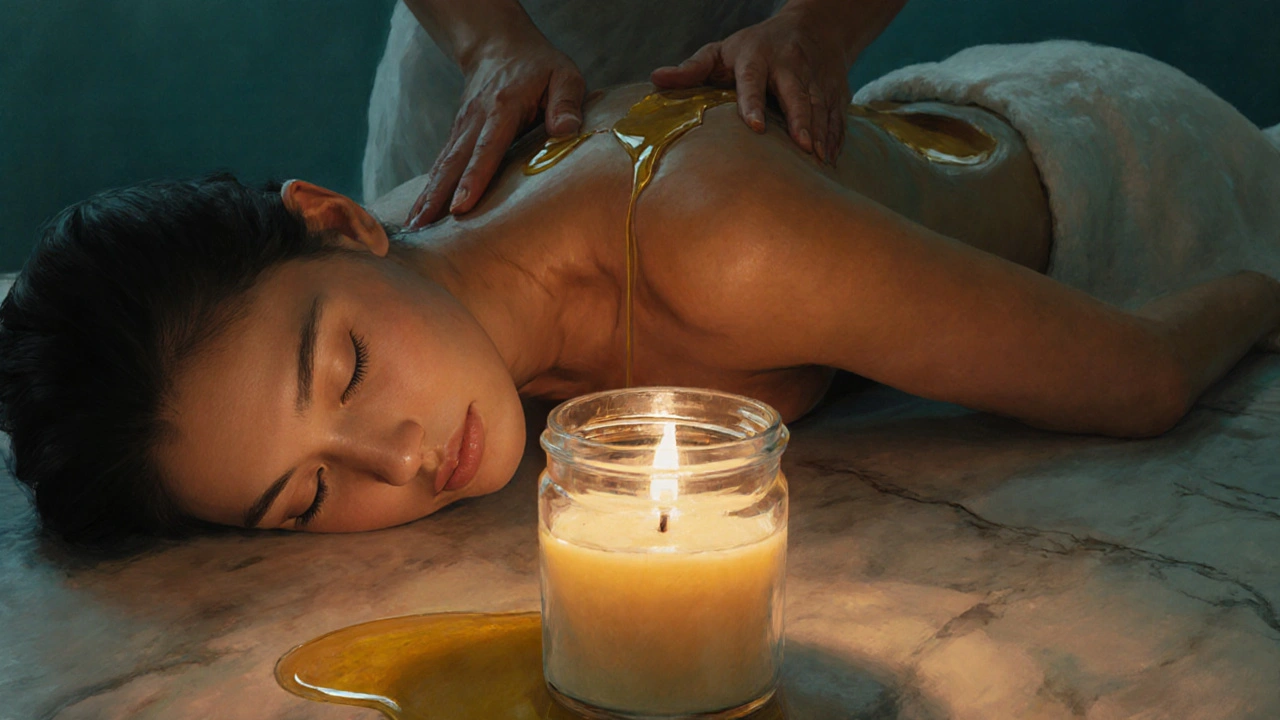
What to Expect During a Candle Massage Session
Imagine a dimly lit room, the soft glow of the candle flickering, a gentle fragrance filling the air. As you dip your fingers into the warm oil, it spreads smoothly, providing a silky glide that helps muscles relax. The heat deepens circulation, making the massage feel richer without any uncomfortable warmth.
Safety Tips - Avoiding Common Pitfalls
- Never use a candle oil on broken or irritated skin - the warmth can intensify discomfort.
- Keep the candle on a stable, heat‑resistant surface; a silicone mat works well.
- Refresh the oil if it starts to cool and solidify; you can gently re‑heat the candle for a few seconds.
- For couples, make sure both partners are comfortable with the scent before lighting.
Comparison: Candle Massage Oil vs. Traditional Massage Oil
| Feature | Candle Massage Oil | Traditional Massage Oil |
|---|---|---|
| Temperature control | Warm, self‑regulating melt point | Room‑temperature or manually heated |
| Aroma | Built‑in essential oil fragrance | Often unscented or requires added fragrance |
| Packaging | Candle jar - dual purpose | Bottle - single purpose |
| Skin benefits | Includes nourishing butters and vitamins | Usually pure carrier oil (e.g., almond, jojoba) |
| Safety | Risk of burns low if temperature monitored | No heat risk, but may cause slipping if over‑applied |
Frequently Asked Questions
Can I use a regular scented candle as a massage oil?
No. Regular candles often contain paraffin, synthetic fragrances, and additives that can irritate the skin. Candle massage oils are formulated with skin‑safe waxes and carrier oils, making them safe for direct skin contact.
How long does the oil stay warm after I blow out the flame?
Typically 10‑15minutes, depending on the room temperature and the wax blend. Keep the jar covered to retain heat if you need a longer session.
Are candle massage oils suitable for pregnant women?
Yes, as long as you choose fragrance‑free or pregnancy‑safe essential oils (like lavender or chamomile) and avoid overheating the oil.
What’s the best way to store leftover candle oil?
Seal the jar tightly and store it in a cool, dark cupboard. This prevents oxidation and keeps the scent fresh for months.
Can I combine two different candle massage oils for a custom blend?
You can, but do a small test first. Mixing oils may alter the melting point and fragrance intensity, so start with a 1:1 ratio and adjust gradually.
Ready to Try?
If you’re looking for a cozy way to upgrade your massage routine, pick a candle massage oil that matches your skin type and scent preference. Light it, melt the oil, and enjoy a spa‑like experience right at home.
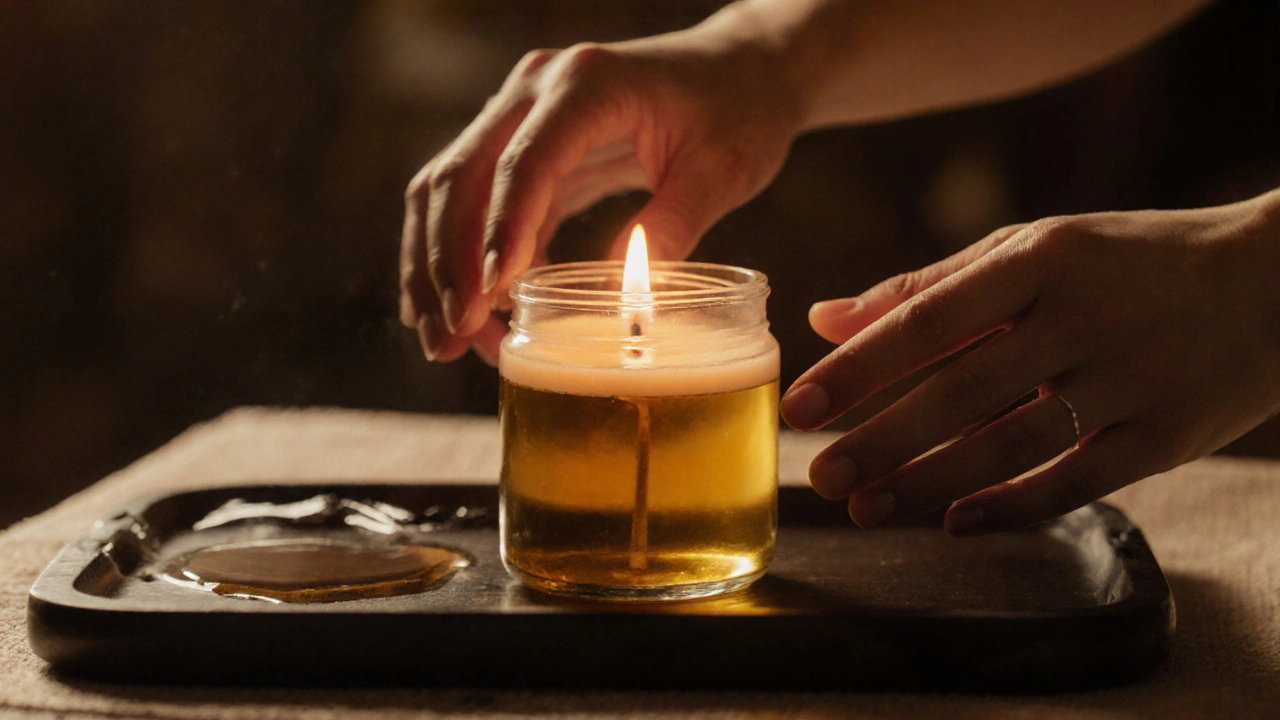
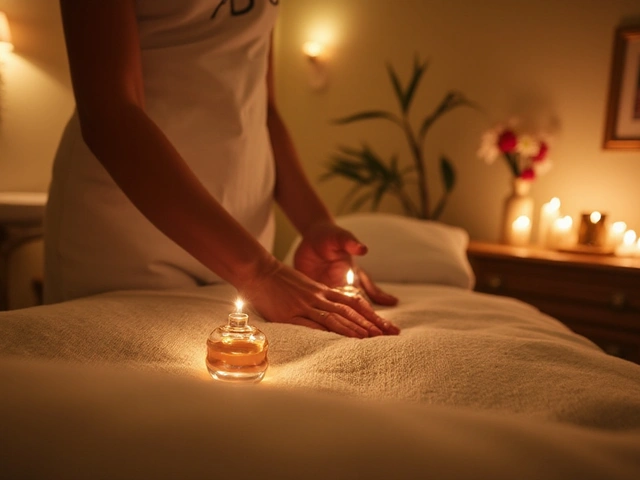

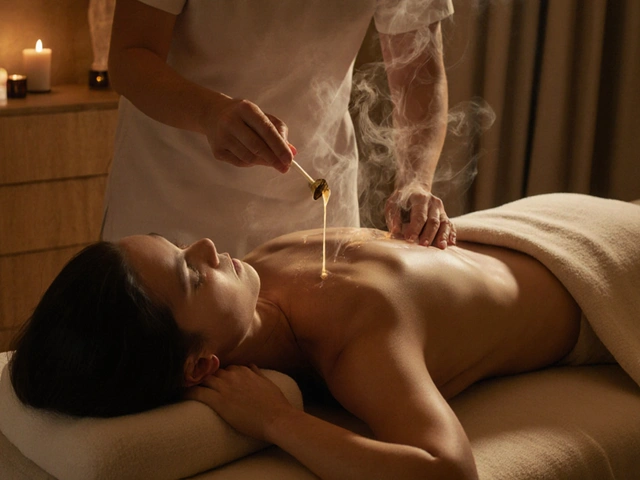
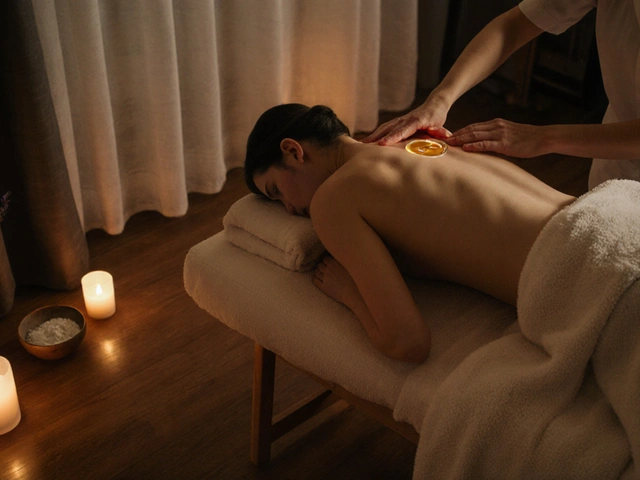

Laura Swan
October 12, 2025 AT 17:46Nothing beats the glow of a home‑grown candle massage oil, especially when it screams American quality!
Nikita Arora
October 12, 2025 AT 18:41Wow, you really think that’s the pinnacle? I’ve tried a dozen imported blends that made my skin feel like silk-no‑flame drama, just pure bliss 😍. The moment the wax melted, I could feel the tension melt away, and the scent hit me like a thunderclap of lavender. Honestly, anyone who settles for “just any” candle oil is missing out on the real magic. Trust me, the warm glow plus that buttery texture is a game‑changer 😉.
Marc Lipscke
October 12, 2025 AT 19:43It’s awesome to see people sharing their experiences; the combination of warmth and aroma really does turn a simple massage into a mini‑spa session. If you keep the wax temperature in that sweet spot, you’ll get that soothing glide without any risk. Keep experimenting with different essential oils-you’ll find a perfect match for your mood in no time! 😊
Vanessa Rose
October 12, 2025 AT 22:13Thank you for compiling such a thorough overview of candle massage oils. The emphasis on low melting points and hypoallergenic options demonstrates a clear understanding of user safety. For individuals with particularly sensitive skin, I would recommend conducting the patch test in a controlled environment, ideally under the guidance of a dermatologist. Additionally, storing the finished product away from direct sunlight preserves both the integrity of the essential oils and the vitamin E antioxidant. When using the oil, applying a thin layer first allows the skin to acclimate to the temperature before a more generous massage. It is also prudent to keep a heat‑resistant mat beneath the candle to prevent accidental burns on surrounding surfaces. Overall, the guide balances practical instructions with scientific rationale, making it a valuable resource for both novices and seasoned practitioners.
Kendra Joiner
October 12, 2025 AT 23:03While candle massage oils are marketed as a seamless fusion of ambience and therapy, the underlying chemistry warrants a more skeptical appraisal.
The premise that a low melting point automatically ensures safety neglects the fact that thermal conductivity of waxes can vary dramatically with ambient conditions.
Consequently, a candle that feels comfortably warm in a heated room may become scalding in a cooler environment, posing an unnoticed burn risk.
Moreover, the inclusion of essential oils, though aromatic, introduces a spectrum of volatile organic compounds that can sensitize even robust skin types.
Studies have demonstrated that repeated dermal exposure to certain terpenes may disrupt the epidermal barrier over time.
The guide’s recommendation of a 24‑hour patch test is prudent, yet it assumes the user will adhere to the protocol without fail.
From a regulatory standpoint, candle massage oils occupy a gray area between cosmetics and therapeutic devices, thereby escaping rigorous safety assessments.
The reliance on natural bases such as soy wax and shea butter, while appealing, does not preclude the presence of residual pesticides or heavy metals inherent to agricultural supply chains.
Consumers often overlook the environmental impact of the packaging, as glass jars contribute to waste unless properly recycled.
The purported synergy between fragrance and skin benefits also raises the question of whether the olfactory stimulus merely masks underlying deficiencies in the carrier matrix.
In practice, the warm oil can alter the skin’s permeability, potentially facilitating deeper penetration of both beneficial and harmful constituents.
The claim that these products are “spa‑like” must therefore be contextualized against the backdrop of cost, accessibility, and the availability of safer, purely carrier‑oil alternatives.
One could argue that the sensory appeal of a flickering flame is itself sufficient to induce relaxation, rendering the added oil redundant.
Nonetheless, when a user prioritizes convenience over meticulous ingredient scrutiny, the risk calculus shifts unfavorably.
It is advisable for discerning individuals to scrutinize the full ingredient disclosure, verify third‑party testing, and consider the long‑term dermatological implications before integrating candle massage oils into a regular regimen.
In summary, while the concept holds aesthetic charm, it is incumbent upon consumers to weigh the allure against the latent hazards embedded within the formulation.